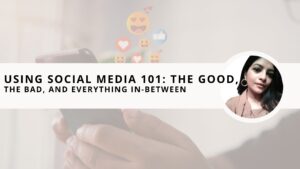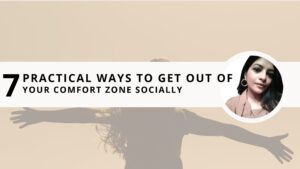As an art enthusiast, I can vouch for its soothing effects on my mind. But, if you have ever had any doubts about the relationship between art and mental health, this blog will clarify that today.
Are you someone who feels that art is just an activity and has nothing to do with your mental health or personality?
Then you are missing out on something incredible my friend. Allow me to tell you how.
Imagine Sara as a happy-go-lucky person who is disciplined in her work completes all of her assignments on time, and is conceived as the happiest person by her coworkers.
In reality, it’s all just on the surface. Behind closed doors, she is suffering from mental discomfort and social anxiety. She feels lonely and is unable to express herself.
Her inner sensation is expanding as a result of being repressed. Her condition is worsening with time.
However, one day she enrolls in an art program despite being extremely disinterested.
She was overwhelmed with emotions, which led her to sketch her heart out.
She began drawing more and more. She eventually articulated her feelings and emotions in the artwork, which relieved the burden off her shoulders.
There must be many people like Sara suffering from mental issues, who feel clueless in life. Art could be the right escape for them.
Let’s dive into understanding how art and mental health can be the cure for each other.
Art and Mental Health: 11 Reasons How They Are Related and Why You Should Practice Them
Art and mental health, together do they sound unfamiliar?
But art is a form of mental therapy that has done wonders for people all around the world.
According to a study, a person who practices art for two or more hours every week is reported to have better mental well-being than those who do not participate in any artistic activities.
How Does Art Impact Your Mental Health?
Art is a non-verbal process. It is about self-expression. The expression of ideas, thoughts, emotions, and behavior that comes from the bottom of your heart.
Artists use visual elements such as colors, shapes, objects, etc. to convey their feelings and evoke powerful emotions in their audience. The deepest expressions leave the deepest impact on people.
Art is found everywhere. You can find them in the patterns of flowers, leaves, spiderwebs, snowflakes, the skin of animals, and the elegance of peacocks.
This world is filled with artistic creations.
All these things follow some pattern—a beautiful pattern if you notice.
ART = EXPRESSION
Creating art has a positive effect on your mental health. It allows you to convey your ideas, emotions, and deepest feelings, which helps you overcome anxiety and depression.
Science shows that art and mental health are so well connected that engaging in artistic activities reduces the level of cortisol (the stress hormone) in the body. This results in reducing stress and negative feelings.
Creating art enhances the level of endorphins in your body, which are neurotransmitters acting as natural painkillers and mood boosters.
Along with that, it increases the level of dopamine too. It is a happy chemical that is associated with motivation, reward, and enthusiasm, ultimately contributing to psychological resilience.
So, art and mental health are complementary to each other. They work together to reduce stress and promote mental well-being. Art is therapy for mental conditions.
Now let’s understand the ultimate reasons why art and mental health are related and why you should practice art forms.
Art and Mental Health: Why is Creativity Good for Mental Health?
Growing up I was an art enthusiast. Before writing found me, I used to draw as a kid.
Art period used to be my favorite in school. It was a different kind of calm from the usual stress around studies.
But, growing up, it was left behind.
Life went on and my first love took a back seat.
But, when my niece told me she wanted to pursue art, I knew I would not let her passion die like mine.
So, her mom and I encouraged her to pursue her passion. We got her to start her Instagram page and YouTube Channel.
View this post on Instagram
Now, she tries different forms of art. I get to work on her projects and heal my inner child too.
Here are 11 ways in which I have felt the connection between art and mental health in my life. I hope you are able to relate the two and feel it in your life too.
1. Art Provides Room for Self-Reflection
Are you someone who finds it extremely difficult to express your true feelings?
You keep all your innermost thoughts to yourself because you are clueless about how to reflect your inner self. This is what consumes most people from within.
Being sad and feeling anxious is not new or very different happening to you. I am one of those people who find it difficult to share my deepest feelings.
But keeping all these thoughts in one side corner of your mind is dangerous too. You will keep on pondering it, and it will consume you internally.
This is where art enters to make you feel more like yourself. It helps you express all your negative emotions, especially the ones you find extremely difficult to accept.
You let it out, whether it is through drawing or music.
This is how art and mental health are connected. Art is a medium of self reflection.
Allow yourself to accept your thoughts while creating your art. Let your ideas flow without any boundaries. Explore all of them and break them, if needed.
Eventually, throw all your thoughts out in the form of art.
2. Art Creates Stories to Express
Art is a medium to express yourself more precisely and represent your story beautifully.
You get highly connected to your favorite art form when any deep stories or meanings are attached to them.
You can be an amazing presenter not by being a top-level artist, but by pouring your heart out. Use all your colors, filling every segment of Canva, and using every prop on the table.
This way, you tell your stories in the best way and make them feel the emotions that you are feeling at the moment. Moreover, there is no fear of judgment. Because it creates a relatable picture.
This is how art and mental health are connected to the level of relatable stories.
3. Art Reduces Your Stress and Anxiety
Make art and get rid of stress. Sounds illogical?
Not only stress but art contributes to overall happiness as well.
It is associated with feelings of pleasure, reward, motivation, and self-esteem. Art and mental health are beautifully blended.
As you are engaged in art making, practice self-compassion and be kind to yourself. Accept imperfections and mistakes as natural.
4. Art Improves Social Interactions
Art, when done in groups, is the most effective way to enhance your mental health and build social connections.
Engaging in group art classes, workshops, therapy sessions, and common projects allows you to connect with people who share similar interests and may have similar struggles too.
These events provide the opportunity to exchange your thoughts, appreciate other work, and review art pieces.
People tend to improve their skills and learn new skills from their fellow participants. It allows you to interact and engage in topics that build mutual understanding and break social barriers.
Overall, art has a great power to bring like-minded people together, establishing connections and improving interpersonal connections.
5. Art Helps in Managing and Controlling Your Emotions
Have you ever been in a situation where you feel lost?
When you are not aware of your feelings, you are unable to find a solution for yourself either.
Art helps you identify your emotions. If you allow your emotions to flow freely while creating art, you can take time to reflect on them. It will help you to acknowledge your feelings and get a better understanding of your vulnerability.
You will be able to find out the root cause of your emotions. This self-awareness is the very first step to controlling your emotions.
When you are aware of your feelings, it becomes less complex to tackle them.
You can explore different colors, textures, shapes, and passionate words to reflect your complex emotions. Be attentive to how your mental health is manifesting in your artwork and what insights you are receiving from your process of art.
Art and mental health are so deeply connected that you can control your emotions while being indulged in artistic works.
6. Art Boosts Your Problem-Solving Ability
Creating art requires you to divert your thinking to different perspectives and brainstorm out-of-the-box ideas. It encourages you to think creatively and explore multiple areas to tackle artistic challenges.
Creating art allows you to explore different perspectives, and various possibilities, and experiment with different designs and forms.
It improves your mental ability to visualize problems and help tackle them from multiple angles. You steal ideas through art, it helps you to step out of your comfort zone.
Art and mental health are connected to problem-solving areas to enhance your mental capability of thinking creatively.
View this post on Instagram
7. Art Helps in Replacing Words With Visuals
Sometimes, it becomes extremely difficult to express your feelings through words. Remember when you say, “I just can’t describe my situation to you!”
When words fall short of expressing your thoughts, art comes to the rescue.
Artistic activities such as drawing, sketches, beats, musical instruments, etc. present the best picture of your inner voice. It possesses the unique quality of breaking linguistic barriers and speaking directly to your soul.
Just think of a breathtaking landscape. The vibrant colors, the hues showing the sunset, and the strokes used in the sky speak volumes without the use of any words.
Or think of the melody of a song. It has the power to transport you to another world, ignite emotions, and bring back memories without any words but by penetrating directly into your soul.
Your personalized art showcases the picture of your feelings, and it’s simpler to understand and relate to.
8. Art Brings You in a Meditative State
What exactly is meditation? Do you think meditation is sitting quietly in a peaceful area, closing your eyes, and encountering no thoughts at all?
Then you have the wrong picture in your mind.
Meditation has various forms, and the best form of meditation is to live in the present moment. Whatever you are doing, just do that. Thoughts pop up, but let them flow easily and pass by.
This is what art does. Art and mental health are associated with the extent of meditation and mindfulness too. Art allows you to wholly invest yourself in the process.
Indulging in artistic activity like mandala meditation really blurs the background world, and lets you focus on the present moment, enjoying your art medium.
Initiate art with mindful practices, take some deep breaths, and be prepared to hide under the art. It helps you divert your mind from the negative state. Let go of all the worries, distractions, and stress, and just express yourself.
ART is not escapism but it’s a CONNECTION. You don’t escape the tensions, but you step towards self-awareness and mental peace.
9. Art Helps in Spirituality
“Art invites us to an encounter, which is a gift—a spiritual gift that might bring us into a deeper relationship with God.” – Brother Lee Colombino, S.J.
Art provides a profound means of expressing spirituality through symbolism and metaphor.
By employing visual imagery, colors, and shapes, artists invite viewers to contemplate deeper spiritual truths and connect with their own beliefs and experiences.
Moreover, art evokes aesthetic superiority, cultivating feelings of awe and wonder that facilitate spiritual experiences.
Through personal expression and transformation, art allows you to know your innermost thoughts and emotions, leading you toward self-discovery, healing, and growth on a spiritual level.
10. Catharsis
Catharsis was adopted in psychology from a Greek drama. It refers to the process of self-expression, pent-up emotional release, purification, and transformation.
This process allows you to tackle challenging and intense emotions such as panic attacks, depression, anger, grief, etc. which ultimately leads to your mental well-being and satisfaction.
Creating art helps with mental purification. Gaining insights into your innermost feelings helps you release emotional energy and sense a greater level of mental well-being.
11. Art Helps You Seek Validation
Through art, you show your artistic capabilities and thoughts.
Your art shows your personality. It provides a feeling of fulfillment when you analyze the results; it gives a sense of satisfaction and happiness from within.
It lets you receive compliments, affirmations, and recognition for your creative efforts. It provides you with creative fulfillment, which has a strongly positive impact on your mental health.
Art promotes self-love. It makes you feel more loved, fulfilled, and satisfied from deep.
How to Incorporate Art into Your Lifestyle?
Though I am a professional writer and blogger now, I have had my way to art through my niece.
If you have ever wanted to incorporate art into your lifestyle, here are a few ways to help you:
- Start by selecting a medium of your interest, whether drawing, cartoons, music, stories, musical instruments, tunes, etc.
- Dedicate at least 2 hours every week to your art.
- It doesn’t have to be perfect. Just sit and express your emotions through art. Most importantly, ignore your self-doubt.
- Let your creativity and your emotions flow freely without any restrictions.
- After the completion of art, reflect on it. Think about how you feel. Journal your thoughts after that.
Basically, art is not just a subject but a powerful tool that you can leverage in a way to get the most out of it.
Art is not only for professional artists; it is for everyone.
Research states that regardless of your skills, art and mental health are very much interconnected.
Hence, make art a part of your self-care routine. Set aside time for activities that help you to know yourself better and nurture your mental health through art.
It is the cheapest, easiest, and most interesting way to take care of yourself.
Conclusion
Art and mental health have always been closely interconnected.
I hope this blog gave you some real insights into the relationship between the two.
From being a medium of self reflection to a way of self expression, art can help you find yourself in the most unique ways.
If you loved what you read, don’t forget to check out my other blog about the benefits of pets on your mental health.



